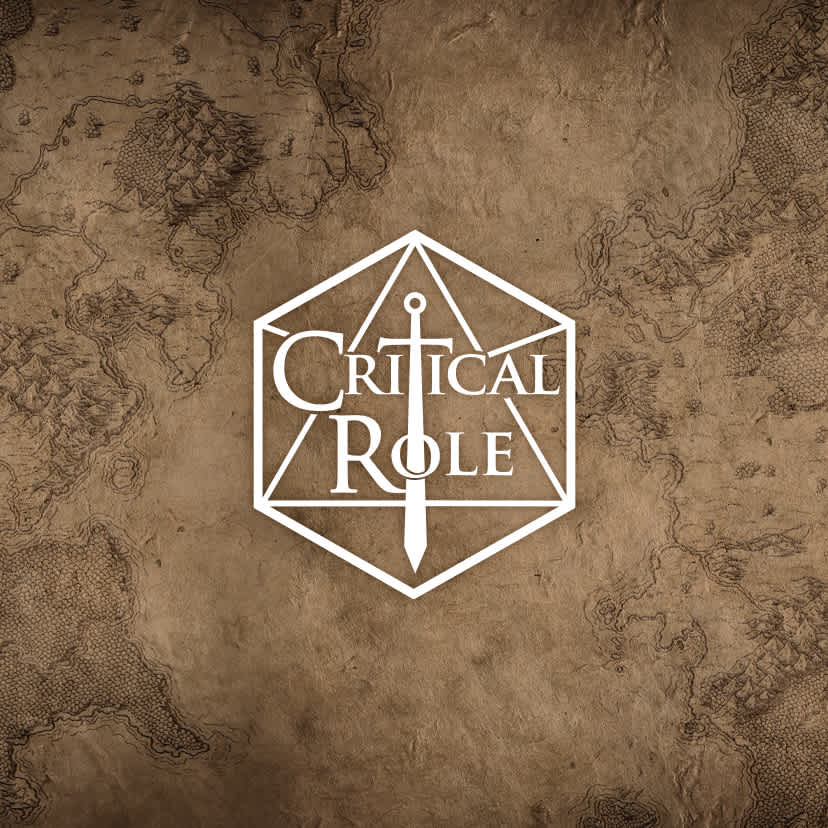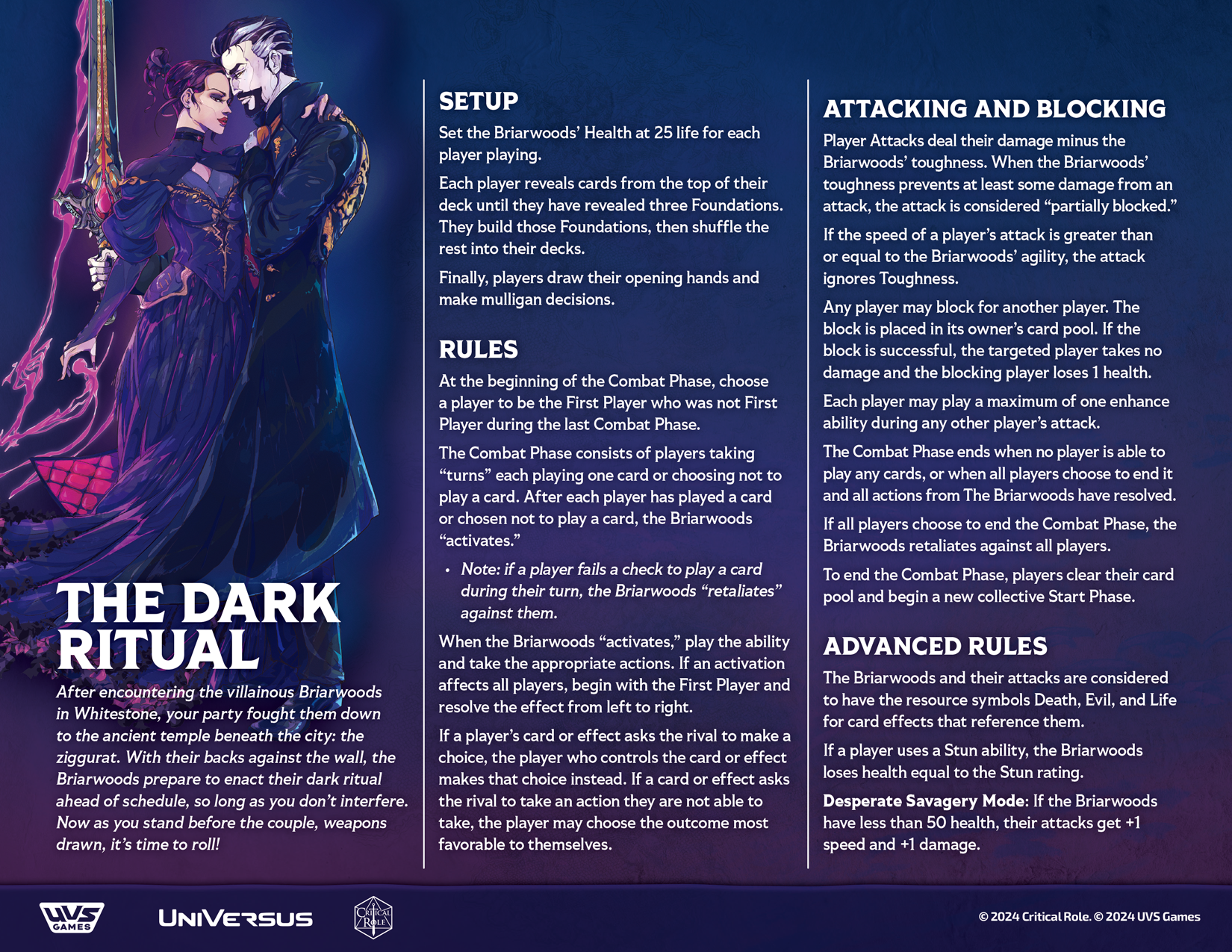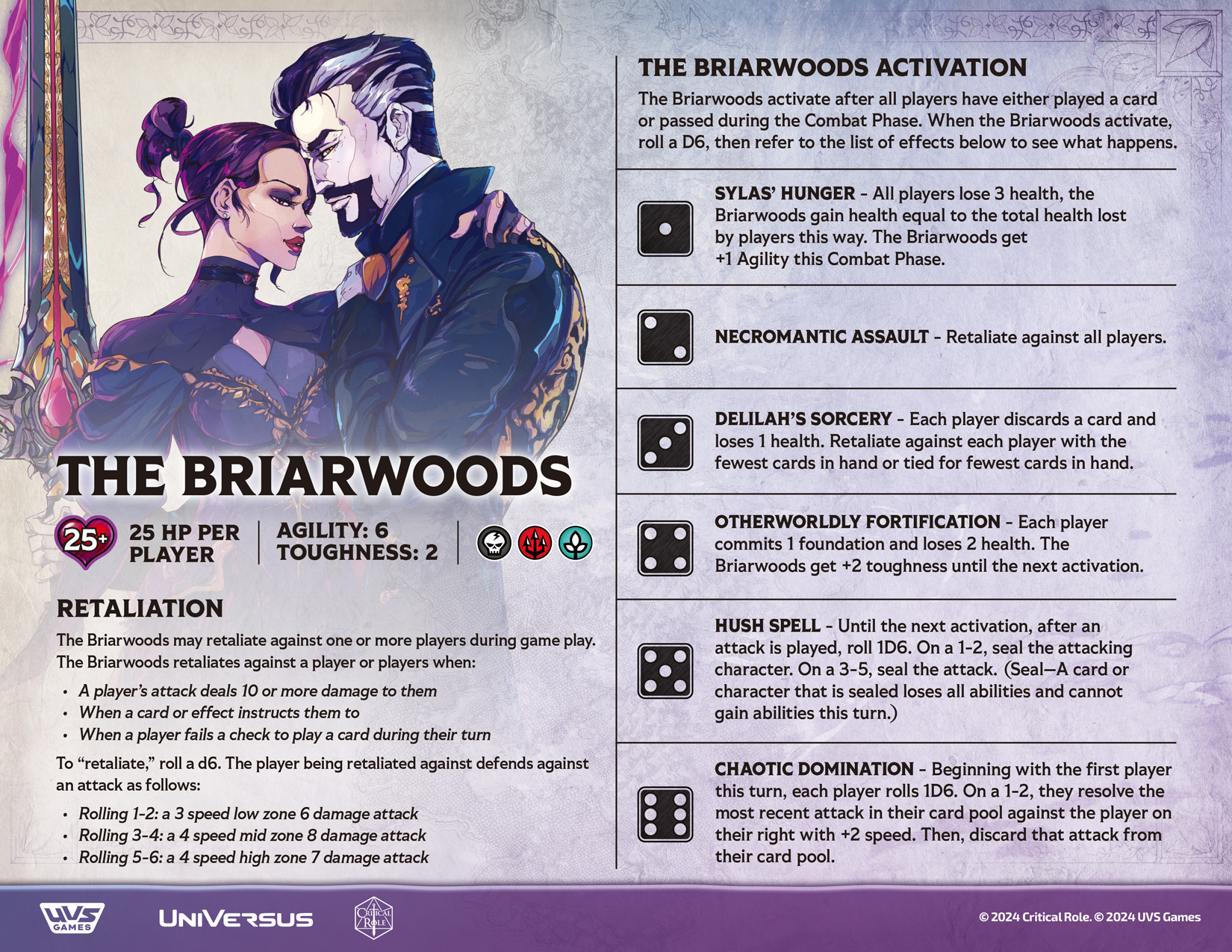

Game Design Article: Crafting a Cooperative Experience
Tim Frie, UVS Games Rules Manager
For launch weekend at participating game stores, get ready to party up and work with your friends to take on the ruthless Briarwoods. An alternative UniVersus format, you’ll work together to take on the Briarwoods in a PvE style co-op game mode. You’ll have to work together with other players to take down this duo. You can take on this PvE style adventure any time, and anywhere. Each player just needs to have a UniVersus deck and the rule cards here. The Briarwoods event taking place at your local game stores between March 21st to 24th will also let you walk away with a collectible art card of the Briarwoods to commemorate the experience of facing off against some of Critical Role’s fiercest foes in the world of UniVersus! Just ask your LGS to take on the Briarwoods with your friends!
Now to take you behind the screen on how this module was created, we are joined by UVS Games Rules Manager, Tim Frie, on how our team crafted this collaborative UniVersus Experience.
Now to take you behind the screen on how this module was created, we are joined by UVS Games Rules Manager, Tim Frie, on how our team crafted this collaborative UniVersus Experience.
Here at UVS Games we’ve had a number of discussions and planning sessions for testing out how to implement a multiplayer experience, or a PvE experience. As you’d guess, most of us play numerous games in the genre and have fond memories of teaming up with friends and trying to take down a certain “icy undead lord”. It’s a thing that many players of our game have been wanting to try for a long time. So, how then do we approach making an experience like that for UniVersus? Especially when our game mechanics are pretty laser-focused on the 1v1 experience.
Creating a PvE experience


We had some immediate questions when this project came up with how this would be implemented. As a special event, we didn’t really have the ability to make a whole deck for an enemy, and planning an auto-piloted deck is something that takes a significant amount of time to get correct. So we settled on a single, double-sided instruction sheet.
The next task was determining what the players would be fighting against. There’s lots of options. Since this was the first try at this sort of experience, we wanted a boss fight that was memorable, significant enough to attract players to want to try it, but not so specifically mechanical as to require a lot of fine tuning. I say this because I knew that this would have to be released, get feedback, and do some iterations after players got to really test it out. In the end, the clear choice for this was the Briarwoods. They are popular antagonists of the Critical Role players, and they are distinct enough to have their own style of combat, but not so much so that this wouldn’t be able to be used as a template for further attempts at this format of play.
Next was how to have players play against an enemy that didn’t have a player. Since Critical Role is based on tabletop roleplaying, I thought some amount of dice rolling HAD to be incorporated. This led me to the most common die that people possess, a 6-sided die. While a 20-sided die might be more thematic, we were more interested in capturing the feel of Critical Role than trying to make some d20 mechanics. Plus, 6 different effects for the enemy to use felt like a decent amount of variety for gameplay. With effects mostly guaranteed to happen, it would provide a fair amount of danger for the players.
Game setup
Figuring out the game setup was fairly simple. If the enemy is going to activate after everyone plays a card, then the players are set up to fail because of the way progression happens in our game. Everyone takes their first turn of a normal game to play as many foundations as they can, with low fear of retribution from their rival. But in the case of this boss battle, the players have no such safety in the first round of play. Because of this, the players needed to be able to jump right into the action. That’s why you automatically build 3 foundations to begin the game. You don’t have to take the whole first Combat Phase to build up your resources, but also, thematically, you’re chasing down a major villain and don’t have much time to fully set up. 3 foundations was determined enough to play at least an attack or two, and then possibly build 1-2 more foundations.
Another key question was the turn sequence. I didn’t want players to have to wait too long to be part of the action. With the players each playing a card right after another, it also keeps the threat of danger as anytime someone is attacked, blocking will be difficult for any given player. Having the party push deeper into the “encounter” or turn together, we keep them on a similar level for interaction. Also, this means that if a player wants to really go ham on a turn, the whole party will have to take the risk together, just like a real boss fight.
Next, I want to cover how the enemy scales based on player count. For this first boss fight, we went with 25 health per player, since there’s a pretty reliable way for the Briarwoods to heal, and the built-in mechanic of Toughness (we’ll go a little more in-depth on that in a moment) helps to keep them around for a bit longer. This means that it’s unlikely to wipe them completely in a single turn. The more players there are, the more likely a player will fail a card on their turn, causing the Briarwoods to attack. Putting pressure on the players is important to making them move forward, rather than stall the game out until they can find their win condition.
Mechanics just for PvE
Toughness and Agility - how did these things happen? I knew from the get go that bosses should have built-in damage reduction. At first, there was no way to bypass it. Just all attacks do 2 less damage, and that felt pretty good. But the problem was that there’s so many effects built in to UniVersus that affect speed as an offensive tool, that pushing speed against an interactive enemy that doesn’t care at all about blocking limited what deck designs could be and made speed affecting abilities seem pointless. That’s when Agility was developed. If we instead create a benchmark you have to reach for some sort of payoff, then reaching that benchmark provides a reason for a lot of effects on cards to be used. If your speed matches or beats the enemy Agility, you get to ignore the enemy Toughness. We really didn’t want a large portion of card text to be useless. This also spawned another fun aspect of Toughness. If the enemy applies Toughness to the damage of a player’s attack, it’s considered partially blocked for effects that care about that. That means that now there’s even more to the choice of “do I want to not make my attacks fast so I can proc ‘on block’ effects, or do I want to deal more damage and add speed to my attack?” Again, more choices lead to more interesting gameplay!
The last thing I want to talk about is how the enemy counterattacks. The regular activations were not enough to be a challenge for the players, and again, blocking is an important part of the game. Any time a deck has reduced the need for a player to block, the game warps in weird ways. So also building in a way for the enemy to use attacks with an attack sequence ended up being important. We ended up with 3 different attacks, so there’s at least a bit of not knowing what exactly will happen. This is good, because again, anytime the players can plan for something they will be able to pretty much deal with it. And without a player making the choices for the enemy, at least random chance can make things risky.
In the end, I think that the boss fight against the Briarwoods is a great first release for a cooperative experience for UVS players old and new. I hope you try it out and enjoy it! Let us know what you think of it once you have.
Check your local retailer here for the Critical Role Challenger Series decks and use them to take down the Briarwoods! Is it Thursday, March 21st yet?
Want to share your voice? Join in on the conversations happening at our:
Product information: Critical Role Challenger Series Product Page
